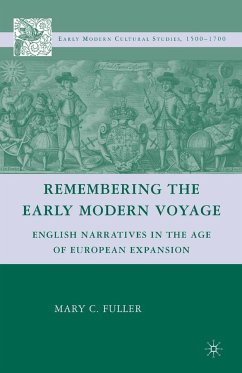
Cyrus Mulready
eBook, PDF
Romance on the Early Modern Stage (eBook, PDF)
English Expansion Before and After Shakespeare

PAYBACK Punkte
20 °P sammeln!






What is dramatic romance? Scholars have long turned to Shakespeare's biography to answer this question, marking his 'late plays' as the beginning and end of the dramatic romance. This book identifies an earlier history for this genre, revealing how stage romances imaginatively expanded audience interest in England's emerging global economy.
Dieser Download kann aus rechtlichen Gründen nur mit Rechnungsadresse in A, B, BG, CY, CZ, D, DK, EW, E, FIN, F, GR, HR, H, IRL, I, LT, L, LR, M, NL, PL, P, R, S, SLO, SK ausgeliefert werden.
Despite the claims of Steven Pinker and others, violence has remained a historical constant since the Enlightenment, even though its forms and visibility have been radically transformed. Accordingly, the studies gathered here recast debate over violence in modern societies by undermining teleological and reassuring narratives of progress.
Produktdetails
- Verlag: Palgrave Macmillan UK
- Seitenzahl: 251
- Erscheinungstermin: 22. August 2013
- Englisch
- ISBN-13: 9781137322715
- Artikelnr.: 39450811
Like many before him, Mulready is tantalized by an inaccessible source of literary riches: the many romance plays produced on the English stage from the 1570s to the 1630s that are now lost. He has to settle for those few romance plays that survive, such as Tom a Lincoln and Clyomon and Clamydes , and the insight they offer into the dramatic potentialities of romance' - TLS JV
D623EF02-FA5C-402C-A682-AEA75C0471DA 760112 Hardback 675125 9781137340917 1137340916 NASA in the World Fifty Years of International Collaboration in Space PSHST;NASA in the World 23/08/2013 08/23/2013 54A History - USA Academic J. Krige; A. Long; A. Maharaj 45483 By (Author) Author Record 1 Georgia Institute of Technology, USA john.krige@hts.gatech.edu 54A
D623EF02-FA5C-402C-A682-AEA75C0471DA 760112 Hardback 675125 9781137340917 1137340916 NASA in the World Fifty Years of International Collaboration in Space PSHST;NASA in the World 23/08/2013 08/23/2013 54A History - USA Academic J. Krige; A. Long; A. Maharaj 45483 By (Author) Author Record 1 Georgia Institute of Technology, USA john.krige@hts.gatech.edu 54A
Mehr anzeigen
History - USA Academic Palgrave Studies in the History of Science and Technology PSHST US Domestic Pal Scholarly V2 - Published and in Stock V6 - Print on Demand HB - History; HBLW3 - Postwar 20th century history, from c 1945 to c 2000; HBJK - History of the Americas; HBTW - The Cold War; HBTB - Social & cultural history HIS036060; HIS054000; HIS037000 History - World History; History - Cultural History; History - United States / 20th Century; History - History of Science; History - United States and North American History; History - Social History; History - History of Medicine, Science and Technology Professional and Scholarly 2013 60.00 60.00 100.00 Green Hardback - ppc (paper over boards) 372 0 229 152 Millimetres 22 235 Millimetres 152667 Grams importv 2014-03-03 05:32:11.560 Words All Formats PART I: 50 YEARS OF NASA AND THE WORLD (John Krige) 1. Introduction and Historical Overview: NASA's International Relations in Space PART II: NASA AND WESTERN EUROPE (John Krige) 2. NASA, Space Science and Western Europe 3. Technology Transfer with Western Europe: NASA-ELDO Relations in the 1960s 4. European Participation in the Post-Apollo Program, 1969-70: The Paine Years 5. European Participation in the post-Apollo Program, 1971: The US Begins to Have Second Thoughts - and So Do the Europeans 6. European Participation in the post-Apollo Program. 1972. Disentangling the Alliance. The Victory of Clean Interfaces PART III: NASA AND THE SOVIET UNION / RUSSIA (Angelina Long Callahan) 7. Sustaining Soviet-American Collaboration, 1957-1989 8. Russian-American Cooperation in Space: Privatization, Remuneration and Collective Security PART IV: NASA'S RELATIONS WITH JAPAN AND INDIA (Ashok Maharaj) 9. An Overview of NASA-Japan Relations: From Pencil Rockets to the International Space Station 10. NASA and the Politics of Delta Launch Vehicle Technology Transfer to Japan 11. An Overview of NASA-India Relations 12. Satellite Broadcasting in Rural India: The SITE Project PART V: INTO THE 21ST CENTURY (John Krige) 13. Space Collaboration Today: The ISS 14. The Impact of ITAR (International Traffic in Arms Regulations) Since its inception, NASA has participated in over 4,000 international projects, yet historians have almost entirely neglected this remarkable aspect of the agency's work. This groundbreaking work is the first to trace NASA's history in a truly international context, drawing on unprecedented access to agency archives and personnel. This will be the definitive history for the foreseeable future on an aspect of NASA history that has been almost entirely neglected Lead author John Krige is one of the most prominent and well-respected historians of the US space program and American science The book will have wide relevance in a number of markets, particularly Western Europe (esp. UK, France, Germany, and Italy), South Africa, India, Australia, and (to a lesser extent) Japan and the former Soviet Union Krige and his collaborators were given full and unprecedented access to all of the relevant NASA records for this project 'Assertions of national pride and global leadership have thoroughly suffused, and often distorted, most US media and historical treatments of the space program. This volume is a long overdue corrective, written by a team led by the preeminent historian of European space exploration. Krige, Callahan, and Maharaj give us as thoroughly researched, complete, and readable an account as one could ask for.' - Sylvia Kraemer, former NASA Chief Historian 'Krige, Callahan, and Maharaj demonstrate that, since the start of the Space Age, NASA engineers and administrators sought to balance national leadership in space with their collaboration and cooperation with foreign partners. NASAin the World is a significant step in helping us see space exploration as both an expression of national foreign policy and a global endeavor.' - W. Patrick McCray, Professor of History, University of California, Santa Barbara, USA 'Far more attention has been paid to competition than cooperation in the history of spaceflight. In this excellent and engaging book, however, the authors make it very clear why studies of cooperation really do matter.' - Robert W. Smith, Professor of the History of Science, University of Alberta, Canada 'By documenting NASA's international relations over its first 50 years, John Krige and his co-authors not only fill a huge gap in NASA history, they bring it to a new level of sophistication and current relevance. Moving beyond nuts and bolts history, the authors admirably succeed in their goal of firmly placing NASA on the world stage, reflecting both the ideals and contradictions of American foreign policy.' - Steven Dick, former NASA Chief Historian JV
D623EF02-FA5C-402C-A682-AEA75C0471DA 760112 Hardback 675125 9781137340917 1137340916 NASA in the World Fifty Years of International Collaboration in Space PSHST;NASA in the World 23/08/2013 08/23/2013 54A History - USA Academic J. Krige; A. Long; A. Maharaj 45484 By (Author) Author Record 2 Naval Research Laboratory, Washington, DC, USA angelina.r.long@gmail.com 54A History - USA Academic Palgrave Studies in the History of Science and Technology PSHST US Domestic Pal Scholarly V2 - Published and in Stock V6 - Print on Demand HB - History; HBLW3 - Postwar 20th century history, from c 1945 to c 2000; HBJK - History of the Americas; HBTW - The Cold War; HBTB - Social & cultural history HIS036060; HIS054000; HIS037000 History - World History; History - Cultural History; History - United States / 20th Century; History - History of Science; History - United States and North American History; History - Social History; History - History of Medicine, Science and Technology Professional and Scholarly 2013 60.00 60.00 100.00 Green Hardback - ppc (paper over boards) 372 0 229 152 Millimetres 22 235 Millimetres 152 667 Grams importv 2014-03-03 05:32:11.560 Words All Formats PART I: 50 YEARS OF NASA AND THE WORLD (John Krige) 1. Introduction and Historical Overview: NASA's International Relations in Space PART II: NASA AND WESTERN EUROPE (John Krige) 2. NASA, Space Science and Western Europe 3. Technology Transfer with Western Europe: NASA-ELDO Relations in the 1960s 4. European Participation in the Post-Apollo Program, 1969-70: The Paine Years 5. European Participation in the post-Apollo Program, 1971: The US Begins to Have Second Thoughts - and So Do the Europeans 6. European Participation in the post-Apollo Program. 1972. Disentangling the Alliance. The Victory of Clean Interfaces PART III: NASA AND THE SOVIET UNION / RUSSIA (Angelina Long Callahan) 7. Sustaining Soviet-American Collaboration, 1957-1989 8. Russian-American Cooperation in Space: Privatization, Remuneration and Collective Security PART IV: NASA'S RELATIONS WITH JAPAN AND INDIA (Ashok Maharaj) 9. An Overview of NASA-Japan Relations: From Pencil Rockets to the International Space Station 10. NASA and the Politics of Delta Launch Vehicle Technology Transfer to Japan 11. An Overview of NASA-India Relations 12. Satellite Broadcasting in Rural India: The SITE Project PART V: INTO THE 21ST CENTURY (John Krige) 13. Space Collaboration Today: The ISS 14. The Impact of ITAR (International Traffic in Arms Regulations) Since its inception, NASA has participated in over 4,000 international projects, yet historians have almost entirely neglected this remarkable aspect of the agency's work. This groundbreaking work is the first to trace NASA's history in a truly international context, drawing on unprecedented access to agency archives and personnel. This will be the definitive history for the foreseeable future on an aspect of NASA history that has been almost entirely neglected Lead author John Krige is one of the most prominent and well-respected historians of the US space program and American science The book will have wide relevance in a number of markets, particularly Western Europe (esp. UK, France, Germany, and Italy), South Africa, India, Australia, and (to a lesser extent) Japan and the former Soviet Union Krige and his collaborators were given full and unprecedented access to all of the relevant NASA records for this project 'Assertions of national pride and global leadership havethoroughly suffused, and often distorted, most US media and historical treatments of the space program. This volume is a long overdue corrective, written by a team led by the preeminent historian of European space exploration. Krige, Callahan, and Maharaj give us as thoroughly researched, complete, and readable an account as one could ask for.' - Sylvia Kraemer, former NASA Chief Historian 'Krige, Callahan, and Maharaj demonstrate that, since the start of the Space Age, NASA engineers and administrators sought to balance national leadership in space with their collaboration and cooperation with foreign partners. NASA in the World is a significant step in helping us see space exploration as both an expression of national foreign policy and a global endeavor.' - W. Patrick McCray, Professor of History, University of California, Santa Barbara, USA 'Far more attention has been paid to competition than cooperation in the history of spaceflight. In this excellent and engaging book, however, the authors make it very clear why studies of cooperation really do matter.' - Robert W. Smith, Professor of the History of Science, University of Alberta, Canada 'By documenting NASA's international relations over its first 50 years, John Krige and his co-authors not only fill a huge gap in NASA history, they bring it to a new level of sophistication and current relevance. Moving beyond nuts and bolts history, the authors admirably succeed in their goal of firmly placing NASA on the world stage, reflecting both the ideals and contradictions of American foreign policy.' - Steven Dick, former NASA Chief Historian JV
D623EF02-FA5C-402C-A682-AEA75C0471DA 760112 Hardback 675125 9781137340917 1137340916 NASA in the World Fifty Years of International Collaboration in Space PSHST;NASA in the World 23/08/2013 08/23/2013 54A History - USA Academic J. Krige; A. Long; A. Maharaj 45485 By (Author) Author Record 3 independent scholar ashokmaharaj@gmail.com 54A History - USA Academic Palgrave Studies in the History of Science and Technology PSHST US Domestic Pal Scholarly V2 - Published and in Stock V6 - Print on Demand HB - History; HBLW3 - Postwar 20th century history, from c 1945 to c 2000; HBJK - History of the Americas; HBTW - The Cold War; HBTB - Social & cultural history HIS036060; HIS054000; HIS037000 History - World History; History - Cultural History; History - United States / 20th Century; History - History of Science; History - United States and North American History; History - Social History; History - History of Medicine, Science and Technology Professional and Scholarly 2013 60.00 60.00 100.00 Green Hardback - ppc (paper over boards) 372 0 229 152 Millimetres 22 235 Millimetres 152 667 Grams importv 2014-03-03 05:32:11.560 Words All Formats PART I: 50 YEARS OF NASA AND THE WORLD (John Krige) 1. Introduction and Historical Overview: NASA's International Relations in Space PART II: NASA AND WESTERN EUROPE (John Krige) 2. NASA, Space Science and Western Europe 3. Technology Transfer with Western Europe: NASA-ELDO Relations in the 1960s 4. European Participation in the Post-Apollo Program, 1969-70: The Paine Years 5. European Participation in the post-Apollo Program, 1971: The US Begins to Have Second Thoughts - and So Do the Europeans 6. European Participation in the post-Apollo Program. 1972. Disentangling the Alliance. The Victory of Clean Interfaces PART III: NASA AND THE SOVIET UNION / RUSSIA (Angelina Long Callahan) 7. Sustaining Soviet-American Collaboration, 1957-1989 8. Russian-American Cooperation in Space: Privatization, Remuneration and Collective Security PART IV: NASA'S RELATIONS WITH JAPAN AND INDIA (Ashok Maharaj) 9. An Overview of NASA-Japan Relations: From Pencil Rockets to the International Space Station 10. NASA and the Politics of Delta Launch Vehicle Technology Transfer to Japan 11. An Overview of NASA-India Relations 12. Satellite Broadcasting in Rural India: The SITE Project PART V: INTO THE 21ST CENTURY (John Krige) 13. Space Collaboration Today: The ISS 14. The Impact of ITAR (International Traffic in Arms Regulations) Since its inception, NASA has participated in over 4,000 international projects, yet historians have almost entirely neglected this remarkable aspect of the agency's work. This groundbreaking work is the first to trace NASA's history in a truly international context, drawing on unprecedented access to agency archives and personnel. This will be the definitive history for the foreseeable future on an aspect of NASA history that has been almost entirely neglected Lead author John Krige is one of the most prominent and well-respected historians of the US space program and American science The book will have wide relevance in a number of markets, particularly Western Europe (esp. UK, France, Germany, and Italy), South Africa, India, Australia, and (to a lesser extent) Japan and the former Soviet Union Krige and his collaborators were given full and unprecedented access to all of the relevant NASA records for this project 'Assertions of national pride and global leadership have thoroughly suffused, and often distorted, most US media and historical treatments of the space program. This volume is a long overdue corrective, written by a team led by the preeminent historian of European space exploration. Krige, Callahan, and Maharaj give us as thoroughly researched, complete, and readable an account as one could ask for.' - Sylvia Kraemer, former NASA Chief Historian 'Krige, Callahan, and Maharaj demonstrate that, since the start of the Space Age, NASA engineers and administrators sought to balance national leadership in space with their collaboration and cooperation with foreign partners. NASA in the World is a significant step in helping us see space exploration as both an expression of national foreign policy and a global endeavor.' - W. Patrick McCray, Professor of History, University of California, Santa Barbara, USA 'Far more attention has been paid to competitionthan cooperation in the history of spaceflight. In this excellent and engaging book, however, the authors make it very clear why studies of cooperation really do matter.' - Robert W. Smith, Professor of the History of Science, University of Alberta, Canada 'By documenting NASA's international relations over its first 50 years, John Krige and his co-authors not only fill a huge gap in NASA history, they bring it to a new level of sophistication and current relevance. Moving beyond nuts and bolts history, the authors admirably succeed in their goal of firmly placing NASA on the world stage, reflecting both the ideals and contradictions of American foreign policy.' - Steven Dick, former NASA Chief Historian JV
C5E3B60A-F3D9-4496-BCF5-AEB1CB1A89B9 774335 Electronic Book Text 688801 9781137350787 1137350784 Britain and the Holocaust Remembering and Representing War and Genocide E.Book HOLC;Britain and the Holocaust 20/11/2013 11/20/2013 542 History - Academic C. Sharples; O. Jensen 17984 Edited By Author Record 2 Former Lecturer in Holocaust Studies and Director School of Historical Studies, University of Leicester 1965-12-07 00:00:00 oje2001@hotmail.com German 542 History - Academic The Holocaust and its Contexts HOLC Scholarly Pal Scholarly E7 - Distributed to Vendors E3 - Basic Record Set Up HBTZ1 - The Holocaust; HBLW - 20th century history: c 1900 to c 2000; HBTZ - Genocide & ethnic cleansing; HBJD1 - British & Irish history; HBWQ - Second World War HIS027100; HIS015000; HIS037070; HIS022000; HIS043000 History - European 20th Century; History - German History; History - British 20th Century; History - British History; History - Social History; History - Jewish History; History - German History; History - Cultural History; History - Holocaust Studies Professional and Scholarly 48.33 95.00 Green EPUB EBook 264 5 sa 2015-06-08 17:31:06.873 Words 102617 All Formats 2013-08-14 12:12:00.000 Full Term Copyright Introduction; Caroline Sharples and Olaf Jensen PART I: CONFRONTING THE HOLOCAUST 1. 'No One Believed What We Had Seen': British Soldiers who Witnessed Mass Murder in Auschwitz; Duncan Little 2. Holocaust on Trial: Mass Observation and British Media Responses to the Nuremberg Tribunal, 1945-6; Caroline Sharples 3. Loose Connections? Britain and the 'Final Solution'; Tony Kushner PART II: THE HOLOCAUST ON SCREEN 4. 'Marvellous Raisins in a Badly-Cooked Cake': British reactions to the screening of Holocaust;Tim Cole 5. 'And the trouble is where to begin to spring surprises on you. Perhaps a place you might least like to remember.' This is Your Life and the BBC's images of the Holocaust in the twenty years before Holocaust; James Jordan 6. The Holocaust in British Television and Film: A Look Over the Fence; Olaf Jensen PART III: THE HOLOCAUST IN EXHIBITIONS 7. Holocaust Art at the Imperial War Museum, 1945-2009; Antoine Capet 8. Holocaust Memory and Contemporary Atrocities: The IWM's Holocaust Exhibition and Crimes Against Humanity Exhibition; Rebecca Jinks 9. The Holocaust and Colonial Genocide at the Imperial War Museum; Tom Lawson PART III: COMMEMORATING THE HOLOCAUST 10. 'We Should Do Something for the Fiftieth': Remembering Auschwitz, Belsen and the Holocaust in Britain in 1995; Mark Donnelly 11. Britain's Holocaust Memorial Day: Inculcating 'British' or 'European' Holocaust Consciousness?; Andy Pearce 12. From Stockholm to Stockton: The Holocaust And/As Heritage in Britain; Dan Stone How has Britain understood the Holocaust? This interdisciplinary volume explores popular narratives of the Second World War and cultural representations of the Holocaust from the Nuremberg trials of 1945-6, to the establishment of a national memorial day by the start of the twenty-first century.
Antoine Capet, University of Rouen, UK
Tim Cole, University of Bristol, UK
Olaf Jensen, University of Leicester, UK
Rebecca Jinks Royal Holloway, University of London, UK
James Jordan, University of Southampton, UK
Tony Kushner University of Southampton, UK
Tom Lawson, University of Winchester, UK
Duncan Little Falmouth College of Arts, UK
Andy Pearce, Institute of Education, University of London, UK
Caroline Sharples, University of Leicester, UK
Dan Stone, Royal Holloway, University of London, UK
JV
C5E3B60A-F3D9-4496-BCF5-AEB1CB1A89B9 774335 Electronic Book Text 688801 9781137350787 1137350784 Britain and the Holocaust Remembering and Representing War and Genocide E.Book HOLC;Britain and the Holocaust 20/11/2013 11/20/2013 542 History - Academic C. Sharples; O. Jensen 46165 Edited By Author Record 1 Lecturer in Modern European History University of Leicester cs383@le.ac.uk British 542 History - Academic The Holocaust and its Contexts HOLC Scholarly Pal Scholarly E7 - Distributed to Vendors E3 - Basic Record Set Up HBTZ1 - The Holocaust; HBLW - 20th century history: c 1900 to c 2000; HBTZ - Genocide & ethnic cleansing; HBJD1 - British & Irish history; HBWQ - Second World War HIS027100; HIS015000; HIS037070; HIS022000; HIS043000 History - European 20th Century; History - German History; History - British 20th Century; History - British History; History - Social History; History - Jewish History; History - German History; History - Cultural History; History - Holocaust Studies Professional and Scholarly 48.33 95.00 Green EPUB EBook 264 5 sa 2015-06-08 17:31:06.873 Words 102617 All Formats 2013-08-14 12:12:00.000 Full Term Copyright Introduction; Caroline Sharples and Olaf Jensen PART I: CONFRONTING THE HOLOCAUST 1. 'No One Believed What We Had Seen': British Soldiers who Witnessed Mass Murder in Auschwitz; Duncan Little 2. Holocaust on Trial: Mass Observation and British Media Responses to the Nuremberg Tribunal, 1945-6; Caroline Sharples 3. Loose Connections? Britain and the 'Final Solution'; Tony Kushner PART II: THE HOLOCAUST ON SCREEN 4. 'Marvellous Raisins in a Badly-Cooked Cake': British reactionsto the screening of Holocaust;Tim Cole 5. 'And the trouble is where to begin to spring surprises on you. Perhaps a place you might least like to remember.' This is Your Life and the BBC's images of the Holocaust in the twenty years before Holocaust; James Jordan 6. The Holocaust in British Television and Film: A Look Over the Fence; Olaf Jensen PART III: THE HOLOCAUST IN EXHIBITIONS 7. Holocaust Art at the Imperial War Museum, 1945-2009; Antoine Capet 8. Holocaust Memory and Contemporary Atrocities: The IWM's Holocaust Exhibition and Crimes Against Humanity Exhibition; Rebecca Jinks 9. The Holocaust and Colonial Genocide at the Imperial War Museum; Tom Lawson PART III: COMMEMORATING THE HOLOCAUST 10. 'We Should Do Something for the Fiftieth': Remembering Auschwitz, Belsen and the Holocaust in Britain in 1995; Mark Donnelly 11. Britain's Holocaust Memorial Day: Inculcating 'British' or 'European' Holocaust Consciousness?; Andy Pearce 12. From Stockholm to Stockton: The Holocaust And/As Heritage in Britain; Dan Stone How has Britain understood the Holocaust? This interdisciplinary volume explores popular narratives of the Second World War and cultural representations of the Holocaust from the Nuremberg trials of 1945-6, to the establishment of a national memorial day by the start of the twenty-first century.
Antoine Capet, University of Rouen, UK
Tim Cole, University of Bristol, UK
Olaf Jensen, University of Leicester, UK
Rebecca Jinks Royal Holloway, University of London, UK
James Jordan, University of Southampton, UK
Tony Kushner University of Southampton, UK
Tom Lawson, University of Winchester, UK
Duncan Little Falmouth College of Arts, UK
Andy Pearce, Institute of Education, University of London, UK
Caroline Sharples, University of Leicester, UK
Dan Stone, Royal Holloway, University of London, UK
JV
24468601-32A2-4735-A323-AED3CA42B54D 760200 Electronic Book Text 675189 9781137341020 1137341025 The Subject of Minimalism On Aesthetics, Agency, and Becoming E.Book Minimalism, Subjectivity 05/09/2013 09/05/2013 51A Literature - USA Academic T. Phillips 45499 By (Author) Author Record 1 English Lecturer North Carolina State University sujet6@gmail.com Thomas Phillips is an English Lecturer at North Carolina State University, USA. 51A Literature - USA Academic US Domestic Pal Scholarly E7 - Distributed to Vendors E3 - Basic Record Set Up DSK - Literary studies: fiction, novelists & prose writers; F - Fiction & related items; ACXJ4 - Art & design styles: Minimalism LIT000000; PHI027000; LIT006000 Literature - Literary Criticism and Theory; Literature - 20th Century and 21st Century Literature; Literature and Language - Modernism Professional and Scholarly 2013 48.33 90.00 10.1057/9781137341020 859260958 Green PDF EBook 208 0 sa 2015-06-08 17:31:06.873 Words All Formats
Introduction
1. Stirrings of Discontent: A Theoretical Context
2. Becoming Fiction: Sarraute, Stein, Hemingway
3. Carver, Sarraute, Toussaint
4. Echenoz, Fabre, DeLillo
5. Lights Camera Action
6. 'Mark the Music': Microsound and Becoming-Silence
7. The Masochistic Body
8. The 'Somaesthetic' Turn: Becoming-Minimal
9. On Virtue, Verbs, and the Virtual
Conclusion and Post Script: On Being Able
Utilizing a wide range of theoretical and creative texts, Phillips offers an examination of subjectivity as considered, enacted, and embodied, through the frame of minimalist aesthetics. Provocatively, he makes the claim that lived experience is capable of being refined according to the paradoxically rich parameters of a minimalist aesthetic.
Annabel Martín
Dartmouth College
1. Critical analysis: Strengths, Weaknesses, Recommendations
This is a very well written, theoretically complex, and conceptually lucid manuscript that wishes to analyze the intersection of aesthetic practices and the articulation of subjectivity: who we are and how we interact with the world and with ourselves. It is a very ambitious project given the depth and breadth of the theoretical and primary texts the author discusses, a wide-ranging and rich corpus of material that includes examples from the different arts, as well as from literary theory, psychoanalysis, deconstruction, and postmodern cultural and social theory. The author is equally sophisticated andsuccessful in his analysis and deep probing of the texts at hand, whether they be philosophical, psychological, cultural, or artistic (literature, performance pieces, or music). The scope of the writing is far-reaching; the project is very ambitious; the mind behind the work is very sharp and insightful. Thomas Phillips proves his talents over and over again.
I do think that the project needs some reworking and reformulation so that the goals of the book can be met with less effort on the part of future readers. The project suffers from the author's need to prove his erudite scholarship with, what are at times, exhaustive exegeses of mostly theoretical texts. His voice gets lost in that mix. It would serve readers more if his questions were foregrounded, if his understanding of the intersection between minimalism (an aesthetic practice) and the formation of an ethical-engaged-subject (a psycho-social practice) were highlighted more often. There are too many places where the theoretical analysis, the need for a hermeneutical argument, overrides the beauty of the project, of what is otherwise very insightful work. My suggestion would be for the author to reduce the theoretical parts of the manuscript substantially and when necessary to make them more relevant to his argument. The best way to produce new knowledge is to show how the work of others has made him think in new, creative, and radical ways.
With this in mind, I would suggest that the theory (both thepsychoanalytical sections and the sections on Gurdjieff) be readdressed and substantially reduced so that they are always a part of the project on minimalism and not be presented to readers on opposite ends of the book. The entanglement and the tensions need to accompany the reader at all times. The same is applicable to the textual analysis of the primary texts. I found his readings to be breathtaking at times but I missed better connections with the overall question of why aesthetic practices are central to the formulation of subjectivity (a very important question that needs to become more central to the book), and why these texts in particular, given their minimalist packaging, were better equipped to produce a kind of subjectivity that can then listen to the complexity of the self and make these formulations central to the making of a wiser, more humane, and just social sphere.
Again, the book is written from a very original and informed perspective. The writing proves that that author is highly qualified for this project. I would advise to make his original insights more central and to make the writing much less abstract for readers.
2. Readership-Course Use
This is a book that scholars and students of several different fields will find important, groundbreaking, and relevant: English, Comparative Literature, Performance Studies, Film Studies, Cultural Studies. In its current stage of writing I see the book geared more towards graduate/postgraduate level discussions. I do think that with some reworking of the material, the author could address a wider audience.
3. Recommendation for Publication
I truly hope Palgrave will consider this manuscript for publication. The work and scholarship is truly innovative and ambitious. I think that after some reworking the manuscript will be ready to see the printed page. My recommendation would be to tentatively accept for publication: to resubmit after reworking.
D623EF02-FA5C-402C-A682-AEA75C0471DA 760112 Hardback 675125 9781137340917 1137340916 NASA in the World Fifty Years of International Collaboration in Space PSHST;NASA in the World 23/08/2013 08/23/2013 54A History - USA Academic J. Krige; A. Long; A. Maharaj 45484 By (Author) Author Record 2 Naval Research Laboratory, Washington, DC, USA angelina.r.long@gmail.com 54A History - USA Academic Palgrave Studies in the History of Science and Technology PSHST US Domestic Pal Scholarly V2 - Published and in Stock V6 - Print on Demand HB - History; HBLW3 - Postwar 20th century history, from c 1945 to c 2000; HBJK - History of the Americas; HBTW - The Cold War; HBTB - Social & cultural history HIS036060; HIS054000; HIS037000 History - World History; History - Cultural History; History - United States / 20th Century; History - History of Science; History - United States and North American History; History - Social History; History - History of Medicine, Science and Technology Professional and Scholarly 2013 60.00 60.00 100.00 Green Hardback - ppc (paper over boards) 372 0 229 152 Millimetres 22 235 Millimetres 152 667 Grams importv 2014-03-03 05:32:11.560 Words All Formats PART I: 50 YEARS OF NASA AND THE WORLD (John Krige) 1. Introduction and Historical Overview: NASA's International Relations in Space PART II: NASA AND WESTERN EUROPE (John Krige) 2. NASA, Space Science and Western Europe 3. Technology Transfer with Western Europe: NASA-ELDO Relations in the 1960s 4. European Participation in the Post-Apollo Program, 1969-70: The Paine Years 5. European Participation in the post-Apollo Program, 1971: The US Begins to Have Second Thoughts - and So Do the Europeans 6. European Participation in the post-Apollo Program. 1972. Disentangling the Alliance. The Victory of Clean Interfaces PART III: NASA AND THE SOVIET UNION / RUSSIA (Angelina Long Callahan) 7. Sustaining Soviet-American Collaboration, 1957-1989 8. Russian-American Cooperation in Space: Privatization, Remuneration and Collective Security PART IV: NASA'S RELATIONS WITH JAPAN AND INDIA (Ashok Maharaj) 9. An Overview of NASA-Japan Relations: From Pencil Rockets to the International Space Station 10. NASA and the Politics of Delta Launch Vehicle Technology Transfer to Japan 11. An Overview of NASA-India Relations 12. Satellite Broadcasting in Rural India: The SITE Project PART V: INTO THE 21ST CENTURY (John Krige) 13. Space Collaboration Today: The ISS 14. The Impact of ITAR (International Traffic in Arms Regulations) Since its inception, NASA has participated in over 4,000 international projects, yet historians have almost entirely neglected this remarkable aspect of the agency's work. This groundbreaking work is the first to trace NASA's history in a truly international context, drawing on unprecedented access to agency archives and personnel. This will be the definitive history for the foreseeable future on an aspect of NASA history that has been almost entirely neglected Lead author John Krige is one of the most prominent and well-respected historians of the US space program and American science The book will have wide relevance in a number of markets, particularly Western Europe (esp. UK, France, Germany, and Italy), South Africa, India, Australia, and (to a lesser extent) Japan and the former Soviet Union Krige and his collaborators were given full and unprecedented access to all of the relevant NASA records for this project 'Assertions of national pride and global leadership havethoroughly suffused, and often distorted, most US media and historical treatments of the space program. This volume is a long overdue corrective, written by a team led by the preeminent historian of European space exploration. Krige, Callahan, and Maharaj give us as thoroughly researched, complete, and readable an account as one could ask for.' - Sylvia Kraemer, former NASA Chief Historian 'Krige, Callahan, and Maharaj demonstrate that, since the start of the Space Age, NASA engineers and administrators sought to balance national leadership in space with their collaboration and cooperation with foreign partners. NASA in the World is a significant step in helping us see space exploration as both an expression of national foreign policy and a global endeavor.' - W. Patrick McCray, Professor of History, University of California, Santa Barbara, USA 'Far more attention has been paid to competition than cooperation in the history of spaceflight. In this excellent and engaging book, however, the authors make it very clear why studies of cooperation really do matter.' - Robert W. Smith, Professor of the History of Science, University of Alberta, Canada 'By documenting NASA's international relations over its first 50 years, John Krige and his co-authors not only fill a huge gap in NASA history, they bring it to a new level of sophistication and current relevance. Moving beyond nuts and bolts history, the authors admirably succeed in their goal of firmly placing NASA on the world stage, reflecting both the ideals and contradictions of American foreign policy.' - Steven Dick, former NASA Chief Historian JV
D623EF02-FA5C-402C-A682-AEA75C0471DA 760112 Hardback 675125 9781137340917 1137340916 NASA in the World Fifty Years of International Collaboration in Space PSHST;NASA in the World 23/08/2013 08/23/2013 54A History - USA Academic J. Krige; A. Long; A. Maharaj 45485 By (Author) Author Record 3 independent scholar ashokmaharaj@gmail.com 54A History - USA Academic Palgrave Studies in the History of Science and Technology PSHST US Domestic Pal Scholarly V2 - Published and in Stock V6 - Print on Demand HB - History; HBLW3 - Postwar 20th century history, from c 1945 to c 2000; HBJK - History of the Americas; HBTW - The Cold War; HBTB - Social & cultural history HIS036060; HIS054000; HIS037000 History - World History; History - Cultural History; History - United States / 20th Century; History - History of Science; History - United States and North American History; History - Social History; History - History of Medicine, Science and Technology Professional and Scholarly 2013 60.00 60.00 100.00 Green Hardback - ppc (paper over boards) 372 0 229 152 Millimetres 22 235 Millimetres 152 667 Grams importv 2014-03-03 05:32:11.560 Words All Formats PART I: 50 YEARS OF NASA AND THE WORLD (John Krige) 1. Introduction and Historical Overview: NASA's International Relations in Space PART II: NASA AND WESTERN EUROPE (John Krige) 2. NASA, Space Science and Western Europe 3. Technology Transfer with Western Europe: NASA-ELDO Relations in the 1960s 4. European Participation in the Post-Apollo Program, 1969-70: The Paine Years 5. European Participation in the post-Apollo Program, 1971: The US Begins to Have Second Thoughts - and So Do the Europeans 6. European Participation in the post-Apollo Program. 1972. Disentangling the Alliance. The Victory of Clean Interfaces PART III: NASA AND THE SOVIET UNION / RUSSIA (Angelina Long Callahan) 7. Sustaining Soviet-American Collaboration, 1957-1989 8. Russian-American Cooperation in Space: Privatization, Remuneration and Collective Security PART IV: NASA'S RELATIONS WITH JAPAN AND INDIA (Ashok Maharaj) 9. An Overview of NASA-Japan Relations: From Pencil Rockets to the International Space Station 10. NASA and the Politics of Delta Launch Vehicle Technology Transfer to Japan 11. An Overview of NASA-India Relations 12. Satellite Broadcasting in Rural India: The SITE Project PART V: INTO THE 21ST CENTURY (John Krige) 13. Space Collaboration Today: The ISS 14. The Impact of ITAR (International Traffic in Arms Regulations) Since its inception, NASA has participated in over 4,000 international projects, yet historians have almost entirely neglected this remarkable aspect of the agency's work. This groundbreaking work is the first to trace NASA's history in a truly international context, drawing on unprecedented access to agency archives and personnel. This will be the definitive history for the foreseeable future on an aspect of NASA history that has been almost entirely neglected Lead author John Krige is one of the most prominent and well-respected historians of the US space program and American science The book will have wide relevance in a number of markets, particularly Western Europe (esp. UK, France, Germany, and Italy), South Africa, India, Australia, and (to a lesser extent) Japan and the former Soviet Union Krige and his collaborators were given full and unprecedented access to all of the relevant NASA records for this project 'Assertions of national pride and global leadership have thoroughly suffused, and often distorted, most US media and historical treatments of the space program. This volume is a long overdue corrective, written by a team led by the preeminent historian of European space exploration. Krige, Callahan, and Maharaj give us as thoroughly researched, complete, and readable an account as one could ask for.' - Sylvia Kraemer, former NASA Chief Historian 'Krige, Callahan, and Maharaj demonstrate that, since the start of the Space Age, NASA engineers and administrators sought to balance national leadership in space with their collaboration and cooperation with foreign partners. NASA in the World is a significant step in helping us see space exploration as both an expression of national foreign policy and a global endeavor.' - W. Patrick McCray, Professor of History, University of California, Santa Barbara, USA 'Far more attention has been paid to competitionthan cooperation in the history of spaceflight. In this excellent and engaging book, however, the authors make it very clear why studies of cooperation really do matter.' - Robert W. Smith, Professor of the History of Science, University of Alberta, Canada 'By documenting NASA's international relations over its first 50 years, John Krige and his co-authors not only fill a huge gap in NASA history, they bring it to a new level of sophistication and current relevance. Moving beyond nuts and bolts history, the authors admirably succeed in their goal of firmly placing NASA on the world stage, reflecting both the ideals and contradictions of American foreign policy.' - Steven Dick, former NASA Chief Historian JV
C5E3B60A-F3D9-4496-BCF5-AEB1CB1A89B9 774335 Electronic Book Text 688801 9781137350787 1137350784 Britain and the Holocaust Remembering and Representing War and Genocide E.Book HOLC;Britain and the Holocaust 20/11/2013 11/20/2013 542 History - Academic C. Sharples; O. Jensen 17984 Edited By Author Record 2 Former Lecturer in Holocaust Studies and Director School of Historical Studies, University of Leicester 1965-12-07 00:00:00 oje2001@hotmail.com German 542 History - Academic The Holocaust and its Contexts HOLC Scholarly Pal Scholarly E7 - Distributed to Vendors E3 - Basic Record Set Up HBTZ1 - The Holocaust; HBLW - 20th century history: c 1900 to c 2000; HBTZ - Genocide & ethnic cleansing; HBJD1 - British & Irish history; HBWQ - Second World War HIS027100; HIS015000; HIS037070; HIS022000; HIS043000 History - European 20th Century; History - German History; History - British 20th Century; History - British History; History - Social History; History - Jewish History; History - German History; History - Cultural History; History - Holocaust Studies Professional and Scholarly 48.33 95.00 Green EPUB EBook 264 5 sa 2015-06-08 17:31:06.873 Words 102617 All Formats 2013-08-14 12:12:00.000 Full Term Copyright Introduction; Caroline Sharples and Olaf Jensen PART I: CONFRONTING THE HOLOCAUST 1. 'No One Believed What We Had Seen': British Soldiers who Witnessed Mass Murder in Auschwitz; Duncan Little 2. Holocaust on Trial: Mass Observation and British Media Responses to the Nuremberg Tribunal, 1945-6; Caroline Sharples 3. Loose Connections? Britain and the 'Final Solution'; Tony Kushner PART II: THE HOLOCAUST ON SCREEN 4. 'Marvellous Raisins in a Badly-Cooked Cake': British reactions to the screening of Holocaust;Tim Cole 5. 'And the trouble is where to begin to spring surprises on you. Perhaps a place you might least like to remember.' This is Your Life and the BBC's images of the Holocaust in the twenty years before Holocaust; James Jordan 6. The Holocaust in British Television and Film: A Look Over the Fence; Olaf Jensen PART III: THE HOLOCAUST IN EXHIBITIONS 7. Holocaust Art at the Imperial War Museum, 1945-2009; Antoine Capet 8. Holocaust Memory and Contemporary Atrocities: The IWM's Holocaust Exhibition and Crimes Against Humanity Exhibition; Rebecca Jinks 9. The Holocaust and Colonial Genocide at the Imperial War Museum; Tom Lawson PART III: COMMEMORATING THE HOLOCAUST 10. 'We Should Do Something for the Fiftieth': Remembering Auschwitz, Belsen and the Holocaust in Britain in 1995; Mark Donnelly 11. Britain's Holocaust Memorial Day: Inculcating 'British' or 'European' Holocaust Consciousness?; Andy Pearce 12. From Stockholm to Stockton: The Holocaust And/As Heritage in Britain; Dan Stone How has Britain understood the Holocaust? This interdisciplinary volume explores popular narratives of the Second World War and cultural representations of the Holocaust from the Nuremberg trials of 1945-6, to the establishment of a national memorial day by the start of the twenty-first century.
Antoine Capet, University of Rouen, UK
Tim Cole, University of Bristol, UK
Olaf Jensen, University of Leicester, UK
Rebecca Jinks Royal Holloway, University of London, UK
James Jordan, University of Southampton, UK
Tony Kushner University of Southampton, UK
Tom Lawson, University of Winchester, UK
Duncan Little Falmouth College of Arts, UK
Andy Pearce, Institute of Education, University of London, UK
Caroline Sharples, University of Leicester, UK
Dan Stone, Royal Holloway, University of London, UK
JV
C5E3B60A-F3D9-4496-BCF5-AEB1CB1A89B9 774335 Electronic Book Text 688801 9781137350787 1137350784 Britain and the Holocaust Remembering and Representing War and Genocide E.Book HOLC;Britain and the Holocaust 20/11/2013 11/20/2013 542 History - Academic C. Sharples; O. Jensen 46165 Edited By Author Record 1 Lecturer in Modern European History University of Leicester cs383@le.ac.uk British 542 History - Academic The Holocaust and its Contexts HOLC Scholarly Pal Scholarly E7 - Distributed to Vendors E3 - Basic Record Set Up HBTZ1 - The Holocaust; HBLW - 20th century history: c 1900 to c 2000; HBTZ - Genocide & ethnic cleansing; HBJD1 - British & Irish history; HBWQ - Second World War HIS027100; HIS015000; HIS037070; HIS022000; HIS043000 History - European 20th Century; History - German History; History - British 20th Century; History - British History; History - Social History; History - Jewish History; History - German History; History - Cultural History; History - Holocaust Studies Professional and Scholarly 48.33 95.00 Green EPUB EBook 264 5 sa 2015-06-08 17:31:06.873 Words 102617 All Formats 2013-08-14 12:12:00.000 Full Term Copyright Introduction; Caroline Sharples and Olaf Jensen PART I: CONFRONTING THE HOLOCAUST 1. 'No One Believed What We Had Seen': British Soldiers who Witnessed Mass Murder in Auschwitz; Duncan Little 2. Holocaust on Trial: Mass Observation and British Media Responses to the Nuremberg Tribunal, 1945-6; Caroline Sharples 3. Loose Connections? Britain and the 'Final Solution'; Tony Kushner PART II: THE HOLOCAUST ON SCREEN 4. 'Marvellous Raisins in a Badly-Cooked Cake': British reactionsto the screening of Holocaust;Tim Cole 5. 'And the trouble is where to begin to spring surprises on you. Perhaps a place you might least like to remember.' This is Your Life and the BBC's images of the Holocaust in the twenty years before Holocaust; James Jordan 6. The Holocaust in British Television and Film: A Look Over the Fence; Olaf Jensen PART III: THE HOLOCAUST IN EXHIBITIONS 7. Holocaust Art at the Imperial War Museum, 1945-2009; Antoine Capet 8. Holocaust Memory and Contemporary Atrocities: The IWM's Holocaust Exhibition and Crimes Against Humanity Exhibition; Rebecca Jinks 9. The Holocaust and Colonial Genocide at the Imperial War Museum; Tom Lawson PART III: COMMEMORATING THE HOLOCAUST 10. 'We Should Do Something for the Fiftieth': Remembering Auschwitz, Belsen and the Holocaust in Britain in 1995; Mark Donnelly 11. Britain's Holocaust Memorial Day: Inculcating 'British' or 'European' Holocaust Consciousness?; Andy Pearce 12. From Stockholm to Stockton: The Holocaust And/As Heritage in Britain; Dan Stone How has Britain understood the Holocaust? This interdisciplinary volume explores popular narratives of the Second World War and cultural representations of the Holocaust from the Nuremberg trials of 1945-6, to the establishment of a national memorial day by the start of the twenty-first century.
Antoine Capet, University of Rouen, UK
Tim Cole, University of Bristol, UK
Olaf Jensen, University of Leicester, UK
Rebecca Jinks Royal Holloway, University of London, UK
James Jordan, University of Southampton, UK
Tony Kushner University of Southampton, UK
Tom Lawson, University of Winchester, UK
Duncan Little Falmouth College of Arts, UK
Andy Pearce, Institute of Education, University of London, UK
Caroline Sharples, University of Leicester, UK
Dan Stone, Royal Holloway, University of London, UK
JV
24468601-32A2-4735-A323-AED3CA42B54D 760200 Electronic Book Text 675189 9781137341020 1137341025 The Subject of Minimalism On Aesthetics, Agency, and Becoming E.Book Minimalism, Subjectivity 05/09/2013 09/05/2013 51A Literature - USA Academic T. Phillips 45499 By (Author) Author Record 1 English Lecturer North Carolina State University sujet6@gmail.com Thomas Phillips is an English Lecturer at North Carolina State University, USA. 51A Literature - USA Academic US Domestic Pal Scholarly E7 - Distributed to Vendors E3 - Basic Record Set Up DSK - Literary studies: fiction, novelists & prose writers; F - Fiction & related items; ACXJ4 - Art & design styles: Minimalism LIT000000; PHI027000; LIT006000 Literature - Literary Criticism and Theory; Literature - 20th Century and 21st Century Literature; Literature and Language - Modernism Professional and Scholarly 2013 48.33 90.00 10.1057/9781137341020 859260958 Green PDF EBook 208 0 sa 2015-06-08 17:31:06.873 Words All Formats
Introduction
1. Stirrings of Discontent: A Theoretical Context
2. Becoming Fiction: Sarraute, Stein, Hemingway
3. Carver, Sarraute, Toussaint
4. Echenoz, Fabre, DeLillo
5. Lights Camera Action
6. 'Mark the Music': Microsound and Becoming-Silence
7. The Masochistic Body
8. The 'Somaesthetic' Turn: Becoming-Minimal
9. On Virtue, Verbs, and the Virtual
Conclusion and Post Script: On Being Able
Utilizing a wide range of theoretical and creative texts, Phillips offers an examination of subjectivity as considered, enacted, and embodied, through the frame of minimalist aesthetics. Provocatively, he makes the claim that lived experience is capable of being refined according to the paradoxically rich parameters of a minimalist aesthetic.
Annabel Martín
Dartmouth College
1. Critical analysis: Strengths, Weaknesses, Recommendations
This is a very well written, theoretically complex, and conceptually lucid manuscript that wishes to analyze the intersection of aesthetic practices and the articulation of subjectivity: who we are and how we interact with the world and with ourselves. It is a very ambitious project given the depth and breadth of the theoretical and primary texts the author discusses, a wide-ranging and rich corpus of material that includes examples from the different arts, as well as from literary theory, psychoanalysis, deconstruction, and postmodern cultural and social theory. The author is equally sophisticated andsuccessful in his analysis and deep probing of the texts at hand, whether they be philosophical, psychological, cultural, or artistic (literature, performance pieces, or music). The scope of the writing is far-reaching; the project is very ambitious; the mind behind the work is very sharp and insightful. Thomas Phillips proves his talents over and over again.
I do think that the project needs some reworking and reformulation so that the goals of the book can be met with less effort on the part of future readers. The project suffers from the author's need to prove his erudite scholarship with, what are at times, exhaustive exegeses of mostly theoretical texts. His voice gets lost in that mix. It would serve readers more if his questions were foregrounded, if his understanding of the intersection between minimalism (an aesthetic practice) and the formation of an ethical-engaged-subject (a psycho-social practice) were highlighted more often. There are too many places where the theoretical analysis, the need for a hermeneutical argument, overrides the beauty of the project, of what is otherwise very insightful work. My suggestion would be for the author to reduce the theoretical parts of the manuscript substantially and when necessary to make them more relevant to his argument. The best way to produce new knowledge is to show how the work of others has made him think in new, creative, and radical ways.
With this in mind, I would suggest that the theory (both thepsychoanalytical sections and the sections on Gurdjieff) be readdressed and substantially reduced so that they are always a part of the project on minimalism and not be presented to readers on opposite ends of the book. The entanglement and the tensions need to accompany the reader at all times. The same is applicable to the textual analysis of the primary texts. I found his readings to be breathtaking at times but I missed better connections with the overall question of why aesthetic practices are central to the formulation of subjectivity (a very important question that needs to become more central to the book), and why these texts in particular, given their minimalist packaging, were better equipped to produce a kind of subjectivity that can then listen to the complexity of the self and make these formulations central to the making of a wiser, more humane, and just social sphere.
Again, the book is written from a very original and informed perspective. The writing proves that that author is highly qualified for this project. I would advise to make his original insights more central and to make the writing much less abstract for readers.
2. Readership-Course Use
This is a book that scholars and students of several different fields will find important, groundbreaking, and relevant: English, Comparative Literature, Performance Studies, Film Studies, Cultural Studies. In its current stage of writing I see the book geared more towards graduate/postgraduate level discussions. I do think that with some reworking of the material, the author could address a wider audience.
3. Recommendation for Publication
I truly hope Palgrave will consider this manuscript for publication. The work and scholarship is truly innovative and ambitious. I think that after some reworking the manuscript will be ready to see the printed page. My recommendation would be to tentatively accept for publication: to resubmit after reworking.
Schließen
Für dieses Produkt wurde noch keine Bewertung abgegeben. Wir würden uns sehr freuen, wenn du die erste Bewertung schreibst!
Eine Bewertung schreiben
Eine Bewertung schreiben
Andere Kunden interessierten sich für











